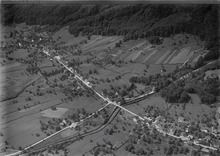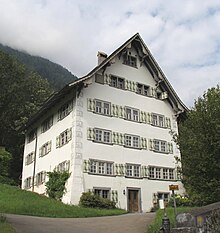Bilten
| Bilten | ||
|---|---|---|
| State : |
|
|
| Canton : |
|
|
| District : | No district division | |
| Political community : | Glarus North | |
| Postal code : | 8865 | |
| former BFS no. : | 1602 | |
| UN / LOCODE : | CH BLT | |
| Coordinates : | 719 948 / 223 446 | |
| Height : | 420 m above sea level M. | |
| Area : | 15.86 km² | |
| Residents: | 2500 (January 8, 2017) | |
| Population density : | 158 inhabitants per km² | |
| map | ||
|
|
||
Bilten (in local dialect : [ ˈb̥ɪlːtə ]) is a former political municipality in the canton of Glarus in Switzerland .
As part of the Glarus community reform , the village was merged with the communities Filzbach , Mollis , Mühlehorn , Näfels , Niederurnen , Oberurnen and Obstalden to form the new community Glarus Nord on January 1, 2011 .
geography
Bilten is located at the foot of the Planggenstock , south of the Linth Canal between Lake Walen and Lake Zurich , about 50 km southeast of Zurich . Almost the entire northern slope of Planggenstock and Hirzli with Alp Nidern, which is cultivated in summer , belonged to the municipality . It is directly connected to Reichenburg by the Ussberg-Nidernstrasse . Bilten is also the northernmost place in the canton of Glarus.
The Biltner Dorfbach demarcates the parts of the village Rufi and Unterbilten. Until 1887 it stepped over its banks several times and was therefore largely canalized. Between Grabenstrasse and the railway line, it flows into a collecting basin, the so-called gravel collector. Then it flows leisurely in an artificial bed into the Linth Canal. Bilten is, so to speak, a street village and consists of the parts Oberbilten, Rufi and Unterilten. Northeast of the village center resp. The industrial zone is located on both sides of the railway line.
In the northwest, on the border with the canton of Schwyz, lies the scattered settlement of Ussbühl (formerly Uspo). Northeast of the Ussbühl there is a sewage treatment plant and the peat pond . During the Second World War, peat was cut there so that groundwater emerged.
Economy and Transport
Bilten has been affected by the main railway axis Zurich - Chur / - Buchs SG since 1875 and by the A3 motorway (Switzerland) since 1974 . In addition to the main roads to Niederurnen and Reichenburg, there is also a direct road connection to the Sanctuary of Schänis . This results in an excellent traffic situation, to which the village owes its name as an industrial location. The most important employer since the 1950s was Gebr. Kunz Fleisch- und Wurstproduktions AG, which went bankrupt in 1995. One subsidiary was Tiefkühlhaus AG, for which there is a successor company. The former factory building belongs to Hof Oberkirch AG in Kaltbrunn . Probably the most important tenant is Koku, a company that deals in bankruptcy goods.
Today Bilten and the Ussbühl are served by the Glarus bus. The concessionaire is the SBB , which awards the transport contract to the Emil Niederer bus operator in Obstalden. Niederer had made a name for himself as a postbus owner and is entrusted with transporting school children by school communities. Due to the low number of boarders on the S2 and S27 lines of the Zurich S-Bahn , Bilten is only partially served. Since then, bus line 524 has been connecting Bilten with the Ziegelbrücke and Pfäffikon SZ every hour. Since 2002, Bilten has been the main location of the PET bottle manufacturer Resilux. Other important employers are Wannerit AG and the construction companies Feldmann and Toneatti. The latter company was run by This Jenny .
The Läderach company , which produces pralines and confectionery, has had its production site in Bilten since 2012.
history
The first documentary mention of the village as Billitun can be found in the deed of donation from Count Arnold von Lenzburg to the Schänis monastery from around the middle of the 11th century. The place name probably goes back to a combination of the Celtic basic word -dūnon , fortified settlement. Kelt is used as a possible front link. bilio- 'tree', idg. bil- 'swamp' or a personal name stem called bili- .
Bilten was defeated in Glarus around 1405 and bought away from the Schäniser monastery in 1412. The first chapel was built in Ussbühl in 1345. After the Reformation , the people of Bilten were part of the church in Niederurnen until the church was built in 1607 . The school community was founded in 1762 with the introduction of a school tax.
Up until the 19th century, a business location as large as it is today was unthinkable in Bilten. The production facilities were heavily dependent on water power, and the Linth , which repeatedly branched out into new arms, could not offer this power.
The closure of Gebr. Kunz AG caused great consternation, and in 2002 tax losses totaling six figures were recorded. A municipal economic commission was formed to establish new businesses in Bilten. However, this body could not make up for the financial losses either.
The local community of Bilten was merged into the new community of Glarus Nord on January 1st, 2011 .
Attractions

The landmarks of Biltens are:
- the Miltsche Ritterhaus, dated 1638, extended by one floor in 1724, on which the eponymous knight's hall is located. In 1977 Ulla Engeberg Killias moved in there and was commissioned with the restoration of this listed building.
- the Elsenerhaus. It was built in 1608 and its gable room was furnished in the Renaissance style by Heinrich Elsener, called Milt, in 1618. From 1853 to 1944 a boys' education institution was housed there.
These houses stand next to each other on Elsenerstrasse, the oldest main street in the canton of Glarus. Both houses are inhabited by the owner or tenant.
power supply
The electricity is distributed through the medium and low voltage network of the electricity supply Bilten (EVB). This sources the electricity from Axpo AG , a major distributor. The main transformer station is located on Sägestrasse. The overhead lines were largely laid under the ground in the 1980s and 1990s.
politics
In the 2006 district elections, the SVP received 494, the CVP 385 and the FDP 229 party votes . No other parties ran for election.
population
In the second half of the 20th century, the community changed from a farming village to an industrial town. During this relatively short period of time, their population tripled.
Personalities
- Ulla Engeberg Killias (1945–1995), painter
- Urs Freuler (* 1958), racing cyclist
- Robert Huber (1933–2016), Swiss-Yenish politician
- Eldin Jakupović (* 1984), goalkeeper
- Heinrich Lienhard (1822–1903), emigrant
- Christoph Stüssi (* 1938), former member of the government, has since moved away from Bilten
- Rolf Widmer (* 1971), acting councilor
- Bandit (rapper)
Web links
- Karin Marti-Weissenbach: Bilten. In: Historical Lexicon of Switzerland .
Individual evidence
- ↑ a b Gabrielle Schmid / Andres Kristol: Bilten GL (Glarus) in: Dictionnaire toponymique des communes suisses - Lexicon of Swiss community names - Dizionario toponomastico dei comuni svizzeri (DTS | LSG). Center de dialectologie, Université de Neuchâtel, Verlag Huber, Frauenfeld / Stuttgart / Vienna 2005, ISBN 3-7193-1308-5 and Éditions Payot, Lausanne 2005, ISBN 2-601-03336-3 , p. 157.
- ↑ Bilten – Ziegelbrücke in the bus in future. In: suedostschweiz.ch. June 30, 2017. Retrieved August 14, 2019 .








